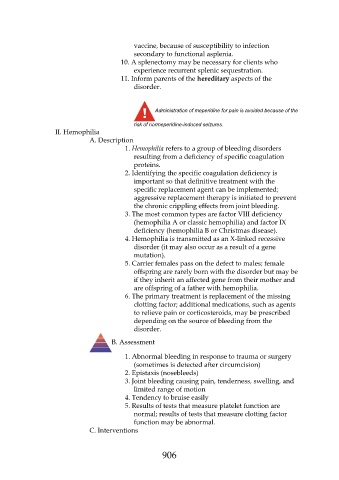Page 906 - Saunders Comprehensive Review For NCLEX-RN
P. 906
vaccine, because of susceptibility to infection
secondary to functional asplenia.
10. A splenectomy may be necessary for clients who
experience recurrent splenic sequestration.
11. Inform parents of the hereditary aspects of the
disorder.
Administration of meperidine for pain is avoided because of the
risk of normeperidine-induced seizures.
II. Hemophilia
A. Description
1. Hemophilia refers to a group of bleeding disorders
resulting from a deficiency of specific coagulation
proteins.
2. Identifying the specific coagulation deficiency is
important so that definitive treatment with the
specific replacement agent can be implemented;
aggressive replacement therapy is initiated to prevent
the chronic crippling effects from joint bleeding.
3. The most common types are factor VIII deficiency
(hemophilia A or classic hemophilia) and factor IX
deficiency (hemophilia B or Christmas disease).
4. Hemophilia is transmitted as an X-linked recessive
disorder (it may also occur as a result of a gene
mutation).
5. Carrier females pass on the defect to males; female
offspring are rarely born with the disorder but may be
if they inherit an affected gene from their mother and
are offspring of a father with hemophilia.
6. The primary treatment is replacement of the missing
clotting factor; additional medications, such as agents
to relieve pain or corticosteroids, may be prescribed
depending on the source of bleeding from the
disorder.
B. Assessment
1. Abnormal bleeding in response to trauma or surgery
(sometimes is detected after circumcision)
2. Epistaxis (nosebleeds)
3. Joint bleeding causing pain, tenderness, swelling, and
limited range of motion
4. Tendency to bruise easily
5. Results of tests that measure platelet function are
normal; results of tests that measure clotting factor
function may be abnormal.
C. Interventions
906

